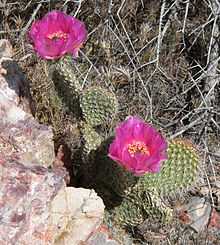Opuntia polyacantha
| Opuntia polyacantha | |
|---|---|
 | |
| Conservation status | |
| Scientific classification | |
| Kingdom: | Plantae |
| (unranked): | Angiosperms |
| (unranked): | Eudicots |
| (unranked): | Core eudicots |
| Order: | Caryophyllales |
| Family: | Cactaceae |
| Genus: | Opuntia |
| Species: | O. polyacantha |
| Binomial name | |
| Opuntia polyacantha Haw. | |
Opuntia polyacantha is a common species of cactus known by the common names plains pricklypear,[1][2] hairspine cactus,[1] panhandle pricklypear,[3] and starvation pricklypear.[4] It is native to North America, where it is widespread in Western Canada, the Great Plains, the central and Western United States, and Chihuahua in northern Mexico.[3][4]
This cactus grows in a wide variety of habitat types, including sagebrush, Ponderosa pine forest, prairie, savanna, shrublands, shrubsteppe, chaparral, pinyon-juniper woodland, and scrub.[1]
Description
Opuntia polyacantha grows up to 40 centimetres (16 in) tall. It forms low mats of pads which may be 2–3 metres (6.6–9.8 ft) wide.[1] Its succulent green pads are oval or circular and reach 27 by 18 centimetres (10.6 by 7.1 in) wide. Its areoles are tipped with woolly brown fibers and glochids. Many of the areoles have spines which are quite variable in size and shape. They may be 0.4 to 18.5 centimetres (0.16 to 7.28 in) in length, stout or thin, straight or curling, and any of a variety of colors.
The flowers are 2.5 to 4 centimetres (0.98 to 1.57 in) long and may be yellow or magenta in color. The fruit is cylindrical, brownish, dry and spiny.[4] The cactus reproduces by seed, by layering, and by resprouting from detached segments.[1]
Uses
Native Americans used it as a medicinal plant, with different parts treating various symptoms. [5]
This pricklypear provides food for many types of animals. It provides over half the winter food for the black-tailed prairie dog in one area. Pronghorn deer eat it, especially after the spines are burned off in wildfires. Ranchers intentionally burn stands of the plant to make it palatable for livestock when little other food is available. It will also grow in waste areas where good forage will not take hold. In fact, an abundance of the cactus indicates land that is poor in quality.[1]
Several insects attack the cactus, including the cactus moth Melitara dentata, the blue cactus borer Olycella subumbrella, and the cactus bug Chelinidea vittiger.[1]
References
- ↑ 1.0 1.1 1.2 1.3 1.4 1.5 1.6 Johnson, K. A. 2000. Opuntia polyacantha. In: Fire Effects Information System, [Online]. U.S. Department of Agriculture, Forest Service, Rocky Mountain Research Station, Fire Sciences Laboratory (Producer). Retrieved May 11, 2011.
- ↑ Opuntia polyacantha. USDA Plants Profile. Retrieved May 11, 2011.
- ↑ 3.0 3.1 Opuntia polyacantha. The Nature Conservancy. Retrieved May 11, 2011.
- ↑ 4.0 4.1 4.2 Opuntia polyacantha. Flora of North America. Retrieved May 11, 2011.
- ↑ University of Michigan - Dearborn: Native American Ethnobotany (Opuntia polyacantha)
External links
| Wikimedia Commons has media related to Opuntia polyacantha. |
- Opuntia polyacantha information from NPGS/GRIN
- USDA Plants Profile for Opuntia polyacantha (plains pricklypear)
- Species account and photographs from Lady Bird Johnson Wildflower Center Native Plant Information Network (NPIN)
- Opuntia polyacantha — CalPhotos Photo Gallery
